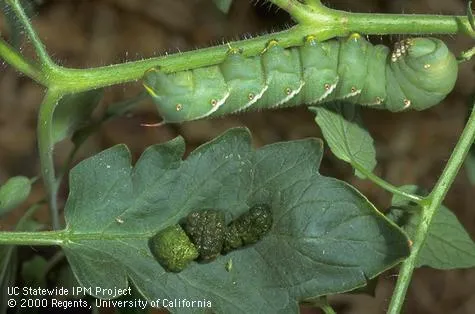
This series provides answers to selected questions recently submitted to the UC Master Gardeners of Yolo County Help Desk.
Question: I am trying to identify what is eating my tomato plants. Some of the leaves have been chewed up and have holes in them. I also noticed black “dots” on some of the leaves.
Answer: Given that this is a tomato plant and based on your description of the leaf damage and the presence of “black dots,” it’s almost certain that the culprit in question is the tomato hornworm. In addition to the holes in your tomato leaves, those black dots are technically referred to as “frass,” but are more commonly known as “insect poop.”
Although confusingly misnamed (it’s actually the caterpillar stage of a moth commonly called the five-spotted hawkmoth), the tomato hornworm is a widespread common pest of tomatoes and other garden crops—but mostly tomatoes.
The tomato hornworm starts out small but by tirelessly devouring your tomato leaves, it soon becomes the Godzilla of the North American caterpillar world: This “worm” can grow as thick as your thumb and up to nearly four inches long. A dark, pointy projection on its back end gives it the “hornworm” label. And this pest is so close in color to the leaf it’s eating that it can be hard to spot, even in broad daylight. But if you look closely, you will probably find one or more hiding among the foliage.
Unlike some other garden pests, you can often see the tomato hornworm at work in your garden in broad daylight; So, no need for midnight sorties with flashlights. Just don a pair of gloves and arm yourself with a strong stomach and the eradication tool of your choice, be it boots, scissors, hand pruners or a bucket of soapy water. Hand picking and immediately halving, squishing or drowning these caterpillars is best. If you feel you must use a less “personal” method, Bacillus thuringiensis (Bt), the most commonly-used “biological pesticide” worldwide, can potentially produce positive results when used on immature tomato hornworm caterpillars. It is available in any nursery.
There’s an exception to this potentially stomach-churning hornworm-eradication policy. If you happen to see a tomato hornworm with what looks like grains of white rice stuck to it, leave that specific critter alone! What you’re seeing is, in fact, a horror show living off of the horror show that is the tomato hornworm in your garden.
Those white-rice shapes are the cocoons of a parasitic wasp, and by the time you see the “rice” on a particular caterpillar, the wasp larvae have already chewed their way from inside the host hornworm and have spun a rice-looking cocoon on the caterpillar’s exoskeleton. You might not be around to see the final curtain to this drama, but soon after the white-rice stage, the young adult wasps emerge from their cocoons, and the hornworm will have long been a mere shell of its former self. All of the females in that brood grow up to in turn lay their own eggs just under the skin of future pesky hornworm caterpillars.
Gardening is a beautiful thing, but it’s not always pretty.
Here is more information: Hornworms, UC IPM
This article previously appeared in the Winters Express and Davis Enterprise.
If you have a gardening question, contact the UC Master Gardener Help Desk at 530-666-8737. Or send an email, with information regarding watering, sun exposure, details about your problem, and photos, when possible, to mgyolo@ucdavis.edu.
Thumbnail Image by Doug Smith from Pixabay
